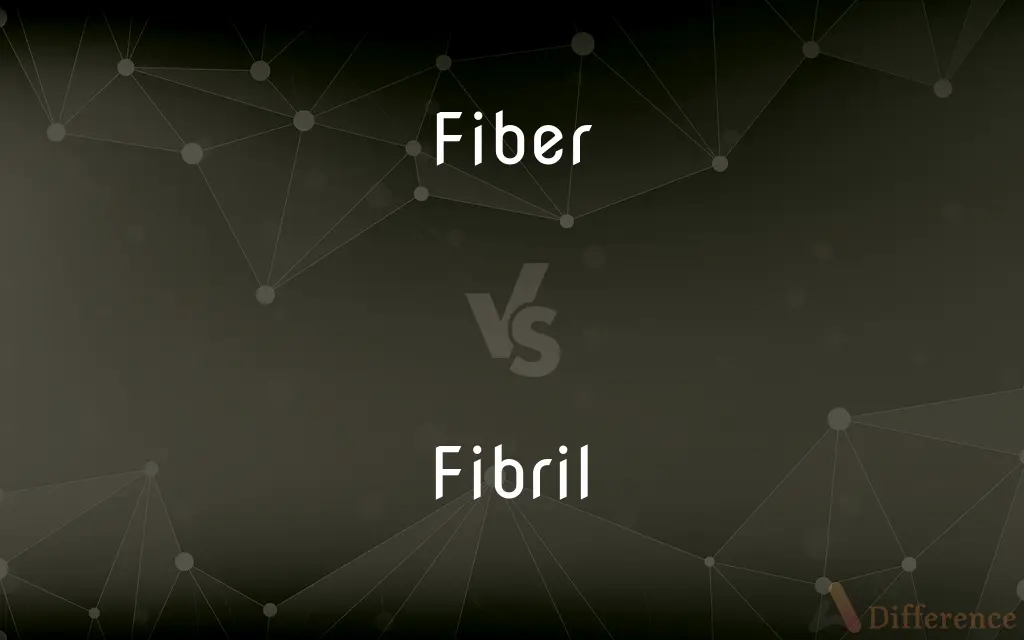Fiber vs. Fibril — What's the Difference?
Edited by Tayyaba Rehman — By Urooj Arif — Updated on April 3, 2024
Fiber is a broad term for thread-like materials, used in textiles and biology, while fibrils are fine fibers, often found in cells and tissues.

Difference Between Fiber and Fibril
Table of Contents
ADVERTISEMENT
Key Differences
Fiber refers to elongated thread-like structures that are fundamental in various applications, including textiles, dietary intake, and biological contexts. These structures provide tensile strength and flexibility to materials and biological entities. Whereas fibrils are a subset of fibers, specifically referring to very fine, thread-like structures that are typically found within cells or making up part of the extracellular matrix in biological tissues. Fibrils can be considered as the micro-components of larger fiber systems, playing critical roles at the microscopic level.
In the textile industry, fiber is a key term that denotes the raw material used to make yarn and fabric. These fibers can be natural, such as cotton, wool, and silk, or synthetic, like polyester and nylon. On the other hand, fibrils are not commonly referenced in textile manufacturing as they pertain more to the microscopic structure of certain natural fibers and their internal makeup rather than being a distinct type of raw material.
In dietary contexts, fiber refers to plant-based carbohydrates that cannot be digested in the human small intestine and are important for digestive health. Fibrils, however, do not have a direct role in dietary discussions. Instead, dietary fiber might consist of various molecular and microscopic structures, including fibrils, that contribute to its overall function in the diet.
In biological tissues, fibers are essential components that provide structural support and strength. These can include muscle fibers, nerve fibers, and connective tissue fibers. Fibrils, within this context, often refer to the finer structures that make up these larger fibers or that are components of the extracellular matrix, such as collagen fibrils, which are crucial for the structural integrity and function of tissues.
At the molecular level, fibers can refer to large, complex structures composed of many molecules, such as polymers in synthetic materials or cellulose in plants. Fibrils, in contrast, often denote the smaller, more specific structures within these larger complexes, showcasing the hierarchical organization of matter from the macroscopic to the microscopic scale.
ADVERTISEMENT
Comparison Chart
Definition
A thread-like structure with various applications in textiles, diet, and biology.
A fine, thread-like structure, often part of a larger fiber system, especially in biological tissues.
Context
Textiles, dietary health, biological tissues.
Primarily biological, at the cellular or molecular level.
Size
Generally larger and visible to the naked eye.
Microscopic, finer than fibers.
Material
Can be natural or synthetic.
Often biological, part of cells or extracellular matrix.
Function
Provides tensile strength, flexibility, and can aid digestion.
Contributes to the microscopic structure and function of tissues.
Compare with Definitions
Fiber
A versatile material found in textiles and biological entities, used for its strength and flexibility.
The sweater was made of a soft, durable fiber that kept warm in the winter.
Fibril
Microscopic, fine fibers, often found in biological contexts like tissues and cells.
Collagen fibrils provide skin with its elasticity and strength.
Fiber
The raw material for making yarn and fabrics, can be natural or synthetic.
The designer preferred natural fibers for their sustainability and breathability.
Fibril
Components of the cytoskeleton, contributing to cell shape and movement.
Actin fibrils play a critical role in the cell's structural integrity.
Fiber
Structural components in organisms, such as muscle or plant fibers.
Muscle fibers contract and relax to produce movement in the body.
Fibril
Structural elements that make up larger fibers or extracellular matrices.
The extracellular matrix is composed of tightly packed collagen fibrils.
Fiber
Dietary component essential for digestive health, not absorbed in the small intestine.
To improve her digestive health, she increased her intake of dietary fiber.
Fibril
Can be involved in pathological conditions, like amyloid fibrils in Alzheimer's.
Amyloid fibrils accumulate in the brain, affecting neural function in Alzheimer's disease.
Fiber
Used in the creation of materials like fiberglass and optical fibers.
The company installed high-speed internet using advanced optical fibers.
Fibril
Studied for their role in the mechanical properties of materials.
Researchers are looking into how fibrils can improve the toughness of bio-inspired materials.
Fiber
Fiber or fibre (from Latin: fibra) is a natural or man-made substance that is significantly longer than it is wide. Fibers are often used in the manufacture of other materials.
Fibril
Fibrils (from the Latin fibra) are structural biological materials found in nearly all living organisms. Not to be confused with fibers or filaments, fibrils tend to have diameters ranging from 10-100 nanometers (whereas fibers are micro to milli-scale structures and filaments have diameters approximately 10-50 nanometers in size).
Fiber
A slender, elongated, threadlike object or structure.
Fibril
A small slender fiber or filament.
Fiber
(Botany) One of the elongated, thick-walled cells that give strength and support to plant tissue.
Fibril
(Anatomy) A threadlike fiber or filament, such as a myofibril or neurofibril, that is a constituent of a cell or larger structure.
Fiber
Any of the filaments constituting the extracellular matrix of connective tissue.
Fibril
A long strand of proteins that are aggregated together in a beta-sheet structure; an amyloid fibril.
Fiber
Any of various elongated cells or threadlike structures, especially a muscle fiber or a nerve fiber.
Fibril
A fine fibre or filament
Fiber
A natural or synthetic filament, as of cotton or nylon, capable of being spun into yarn.
Fibril
(biology) Any fine, filamentous structure in animals or plants
Fiber
Material made of such filaments.
Fibril
A small fiber; the branch of a fiber; a very slender thread; a fibrilla.
Fiber
An essential element of a person's character
"stirred the deeper fibers of my nature" (Oscar Wilde).
Fibril
A very slender natural or synthetic fiber
Fiber
Strength of character; fortitude
Lacking in moral fiber.
Fiber
Coarse, indigestible plant matter, consisting primarily of polysaccharides such as cellulose, that when eaten stimulates intestinal peristalsis. Also called bulk, roughage.
Fiber
(countable) A single elongated piece of a given material, roughly round in cross-section, often twisted with other fibers to form thread.
The microscope showed a single blue fiber stuck to the sole of the shoe.
Fiber
(uncountable) A material in the form of fibers.
The cloth is made from strange, somewhat rough fiber.
Fiber
(textiles) A material whose length is at least 1000 times its width.
Please use polyester fiber for this shirt.
Fiber
Dietary fiber.
Fresh vegetables are a good source of fiber.
Fiber
(figuratively) Moral strength and resolve.
The ordeal was a test of everyone's fiber.
Fiber
(mathematics) The preimage of a given point in the range of a map.
Under this map, any two values in the fiber of a given point on the circle differ by 2π.
Fiber
(category theory) The pullback of a morphism along a global element (called the fiber of the morphism over the global element).
Fiber
(computing) A kind of lightweight thread of execution.
Fiber
(cytology) A long tubular cell found in bodily tissue.
Fiber
One of the delicate, threadlike portions of which the tissues of plants and animals are in part constituted; as, the fiber of flax or of muscle.
Fiber
Any fine, slender thread, or threadlike substance; as, a fiber of spun glass; especially, one of the slender rootlets of a plant.
Fiber
The inherent complex of attributes that determine a person's moral and ethical actions and reactions; sinew; strength; toughness; as, a man of real fiber.
Yet had no fibers in him, nor no force.
Fiber
A general name for the raw material, such as cotton, flax, hemp, etc., used in textile manufactures.
Fiber
That portion of food composed of carbohydrates which are completely or partly indigestible, such as cellulose or pectin; it may be in an insoluble or a soluble form. It provides bulk to the solid waste and stimulates peristalsis in the intestine. It is found especially in grains, fruits, and vegetables. There is some medical evidence which indicates that diets high in fiber reduce the risk of colon cancer and reduce cholesterol levels in the blood. It is also called dietary fiber, roughage, or bulk.
Fiber
A leatherlike material made by compressing layers of paper or cloth.
Fiber
A slender and greatly elongated solid substance
Fiber
The inherent complex of attributes that determine a persons moral and ethical actions and reactions;
Education has for its object the formation of character
Fiber
A leatherlike material made by compressing layers of paper or cloth
Common Curiosities
Can fibrils be seen with the naked eye?
No, fibrils are microscopic and cannot be seen without magnification.
How do fibers contribute to our health?
Dietary fibers aid in digestion and help maintain gut health.
Do fibrils have any technological applications?
Research into fibrils aims at enhancing materials' mechanical properties but they are more studied in biological contexts.
Are all fibers biodegradable?
Natural fibers are biodegradable, whereas many synthetic fibers are not.
How are fibers used in textiles?
Fibers are spun into yarns, which are then woven or knitted into fabrics.
Can increasing dietary fiber intake improve health?
Yes, it can enhance digestive health and prevent various diseases.
What role do fibrils play in biological tissues?
They provide structural support and contribute to the tissue's mechanical properties.
How do fibers affect the environment?
Natural fibers are generally more environmentally friendly, while synthetic fibers can contribute to pollution.
What is the significance of actin fibrils in cells?
Actin fibrils are crucial for cell movement and structural integrity.
What is the main difference between fiber and fibril?
Fiber is a general term for thread-like materials, while fibrils are fine fibers, especially in biological contexts.
Can fibers be both natural and synthetic?
Yes, fibers include a broad range of materials from cotton and wool to polyester and nylon.
Are synthetic fibers considered eco-friendly?
Synthetic fibers can be less eco-friendly due to their production processes and difficulty in decomposing.
What distinguishes collagen fibrils from other fibrils?
Collagen fibrils are specific to connective tissues, providing strength and elasticity.
Why are fibrils important in materials science?
Understanding fibrils can lead to the development of stronger, more resilient materials.
How do amyloid fibrils relate to diseases?
Amyloid fibrils are associated with diseases like Alzheimer's, where they accumulate abnormally.
Share Your Discovery

Previous Comparison
Purgative vs. Emetic
Next Comparison
Forbid vs. PreventAuthor Spotlight
Written by
Urooj ArifUrooj is a skilled content writer at Ask Difference, known for her exceptional ability to simplify complex topics into engaging and informative content. With a passion for research and a flair for clear, concise writing, she consistently delivers articles that resonate with our diverse audience.
Edited by
Tayyaba RehmanTayyaba Rehman is a distinguished writer, currently serving as a primary contributor to askdifference.com. As a researcher in semantics and etymology, Tayyaba's passion for the complexity of languages and their distinctions has found a perfect home on the platform. Tayyaba delves into the intricacies of language, distinguishing between commonly confused words and phrases, thereby providing clarity for readers worldwide.
















































